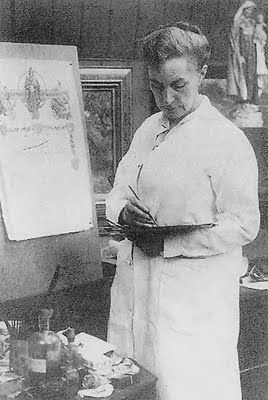
My featured artist today is the Victorian painter Mary Eleanor Fortescue-Brickdale, one of the most popular artists of her time. She is perhaps best remembered for reawakening the Pre-Raphaelite style of painting at the end of the 19th century as shown in her moral or medieval depictions with their vibrant and flamboyant colours. The Pre-Raphaelite group was founded in 1848 by John Everett Millais, William Holman Hunt and Dante Gabriel Rossetti but by the time Eleanor went to art school in 1889, Pre-Raphaelite painting was led by a second generation of artists which included Edward Burne-Jones. Eleanor admired their work and carefully followed in their footsteps which helped keep the style alive until the start of the twentieth century. Eleanor was not simply a painter. She was also a designer, produced stained-glass windows and small-scale sculptures, illustrated books as well as completing numerous watercolour and oil paintings.

Mary Eleanor Fortescue-Brickdale was born at the family home in the prosperous London suburb of Upper Norwood on January 25th, 1872. Her father Matthew Inglett Fortescue-Brickdale was a barrister of Lincoln’s Inn who married, Sarah Ann Lloyd, the daughter of Judge Edward John Lloyd QC, of the Bristol county court. Eleanor was the youngest of five children. She had two brothers, Charles, the eldest child, who was born in 1857, John Matthew and two sisters, Kate, and Ann. Ann died aged six, four years before Eleanor was born. The family financial circumstances were sound, and they employed four servants and a governess for Eleanor. As was the norm at that time, the parents were preoccupied with their sons’ future ensuring they had the best schooling and went on to a financially-sound profession whilst being ambivalent with regards their daughters’ future believing that the future happiness of their daughters was a good, kind, and wealthy husband!

Charles, an amateur artist who, attended Westminster School and Christ Church, Oxford University, followed in his father’s footsteps and became a barrister focusing on land law and in 1900 was appointed Chief Registrar of HM Land Registry. He was famed for modernising the Land Registry system. John, who was two years older than Eleanor, went into medicine and became a physician in Bristol and contributed many articles for medical journals and co-authored a couple of medical books. Ironically, despite their parent’s plans, neither Kate nor Eleanor married. Little is known of Kate but of course we do know that Eleanor’s love of art was to contribute to her fame and financial stability.
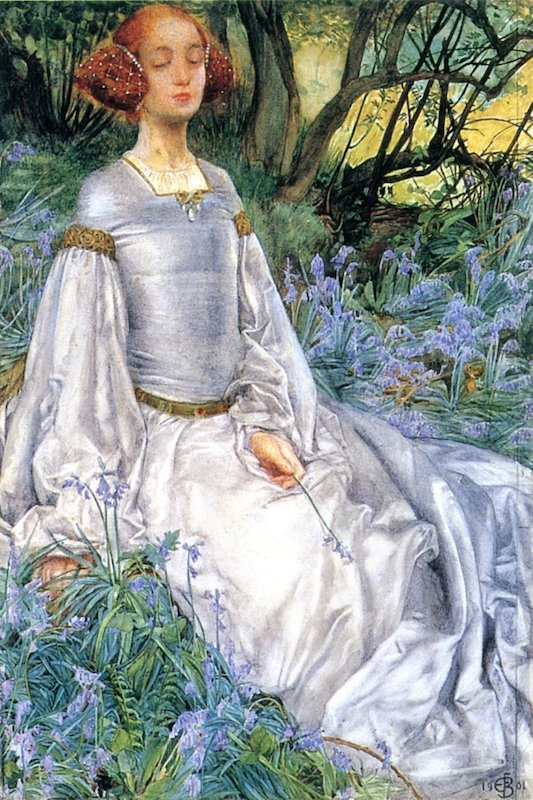
One must presume Eleanor’s interest in art was fostered by her parents who looked upon the ability to paint and draw, as simply a hobby for females but one which would prove attractive to suitors. Another reason could be that her father had an interest in art and had John Ruskin as a fellow Oxford University student. Matthew Fortescue-Brickdale was involved in one of Ruskin’s art projects, the Arundel Society, which was founded to promote knowledge of the art works of the old Italian, Flemish, and other European Masters and to conserve and document works of art which were at risk of destruction. It is believed that her father’s love of art resulted in visits with his children to art galleries.
After completing her home schooling in 1889, seventeen-year-old Eleanor enrolled at the Crystal Palace School of Art, Science and Literature. It was not one of the most prestigious establishment but maybe it was chosen for Eleanor for its closeness to the family home. It was a mixed college, but the art classes were for female students only, the science for male students and the music was for both. Eleanor proved an able student and at the end of her first year, was awarded the annual scholarship for crayon drawing and watercolours and in 1892 she gained a silver medal for watercolour.

In 1894, tragedy struck the Fortescue-Brickdale household when Eleanor’s father, Matthew was killed whilst mountain climbing in the Alps.
Around the mid 1890’s, wanting a more prestigious art school which offered tuition by well-known artists who would develop her talent, Eleanor enrolled at the St John’s Wood School. The art school had another important role. It was an established feeder school for students who wanted to enrol at the prestigious Royal Academy Schools. Proof of this comes from the statistic that in the first half of the 1890’s of the 394 students who were admitted to the RA Schools, 250 came from the St John’s Wood School. St John’s Wood School also offered life drawing classes with nude models to both its male and female students.
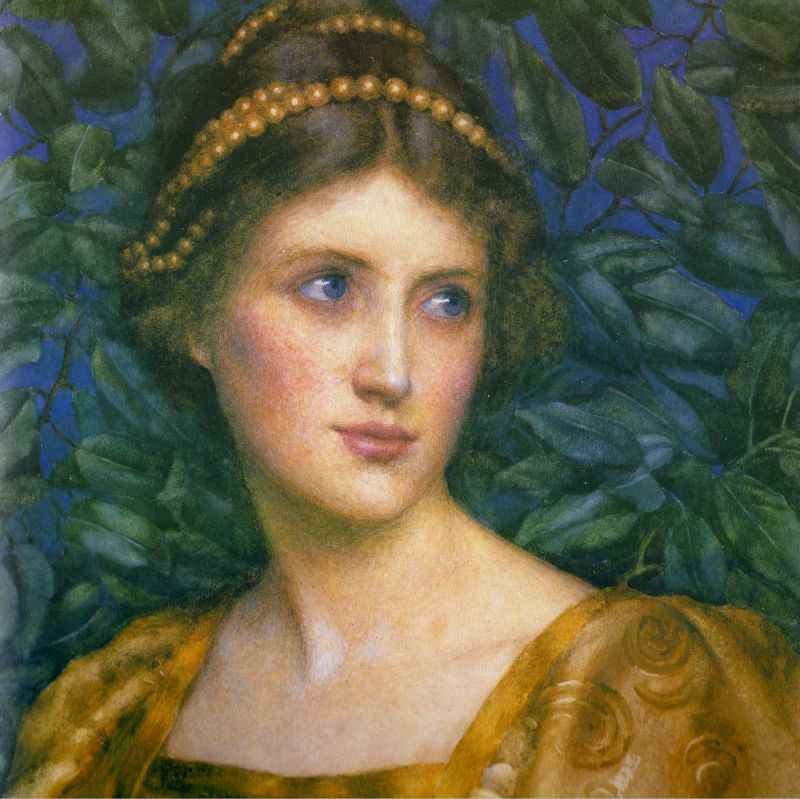
To achieve admission into the Royal Academy Schools, the candidate had to submit certain pieces of art and if they were found acceptable the candidate would become a probationer and then, if their work during the next three months was up to the standard required, they would become a full student and be allowed to start one of the courses. In the Magazine of Art, 25, 1902, an article appeared written by Marion Hepworth Dixon , Our rising Artists: Eleanor Fortescue-Brickdale in which she wrote that it took Eleanor three attempts to get to become a probationer but once that was achieved in January 1895, she only remained as such for three weeks before becoming a full-student and starting an art course. In 1897 Eleanor was awarded a prize by the Royal Academy Schools for her work as a designer and promising decorative designer.

For any up-and-coming artist wanting to establish a reputation, social connections were of paramount importance to achieving commissions and acquiring a wealthy patron. Eleanor’s education had been different to many other aspiring painters. She had not attended school, her parents deciding on home schooling, she had not attended a university and now at the age of twenty-five remained unmarried, all of which resulted in her not having many outside connections which would have helped her through her artistic life and so, she had to rely on her family and friends for a helping hand.

Her first breakthrough came in the form of a “brotherly helping-hand”. Charles her eldest brother who was working at the Land Registry persuaded her to design a certificate of registration for his newly re-organised Land Registry office.

In the same year her brother Charles helped her once again. He had married Mabel Gibbs, whose brother James Gibbs an amateur cricketer who had played for the MCC, and a writer who, that year, had published a book, A Cotswold Village; or, country life and pursuits in Gloucestershire, and had Eleanor illustrate it with twenty pen and ink sketches of rural scenes. Later her reputation was further advanced when she provided pen and ink sketches for the illustrated version of Walter Scott’s Ivanhoe.
Her reputation as a talented illustrator soon grew and her design work was in great demand from such popular journals as Country Life and The Ladies’ Field. Her “audience” were the wealthy landowners some of who became her patrons and would often call upon her to paint pictures of their family and stately homes.

In 1899 she completed her first major work of art entitled The Pale Complexion of True Love which was accepted for inclusion in that year’s Royal Academy Annual Exhibition. The title of the work is taken from Act 3 Scene IV of Shakespeare’s pastoral comedy, As You Like It, when the elderly shepherd, Corin speaks of the shepherd, Silvius’ unrequited love for the shepherdess, Phebe:
“…If you will see a pageant truly play’d,
Between the pale complexion of true love
And the red glow of scorn and proud disdain,
Go hence a little and I shall conduct you,
If you will mark it…”
The first thing that strikes you with this painting is the sumptuous red of the lady’s gown. It is interesting how the artist has used such a bright spectrum of colours. To many people, the Pre-Raphaelite painters use of bright colours was garish and lacked delicacy. To others it was this vibrancy of colour which heightened their work, but I will leave you to decide.

In 1899 Eleanor produced a painting, The Gift That is Better Than Rubies, a title derived from a passage in the Bible – Proverbs 8: 10-11.
“…Receive my instruction, and not silver; and knowledge rather than choice gold. For wisdom is better than rubies; and all the things that may be desired are not to be compared to it…”

In the summer of 1899, father and son art dealers, William and Walter Dowdeswell who ran a gallery in New Bond Street, London, commissioned Eleanor to produce a large number of watercolour paintings for their 1901 show which was entitled Such stuff as dreams are made of, a line from Shakespeare’s play The Tempest. The depictions in these works covered subjects from the Bible, Shakespeare, Browning and Coleridge. One of her watercolour paintings on show at this exhibition was The Gilded Apple. It depicts a fairy tale princess being thrown a gilded apple. She leans back in an attempt to catch it and her crown tumbles from her head and is about to fall into a fishpond behind her. Meanwhile we see a cat ready to pounce on one of the fish in the pond. The commission had been so big that Eleanor had decided to acquire her own studio in Holland Park, and area populated by many artists. The show was a spectacular success and all the paintings were sold. In an article in the June edition of The Artist praise was heaped upon her:
“…Rarely, if ever, has a woman painter made a great reputation as quickly and thoroughly as Miss Eleanor Fortescue-Brickdale, whose series of watercolour drawings has, during the last month, drawn the whole of artistic London to the Dowdeswell Galleries…”

One of Eleanor’s best-known paintings is one she completed in 1905 and is entitled The Little Foot Page which is now part of the Walker Art Gallery collection in Liverpool. This painting illustrates lines from a 1765 ballad Child Waters sometimes known as Burd Helen, part of the collection of traditional folk ballads by Thomas Percy’s Reliques of Ancient English Poetry. The ballad describes the loyalty of Ellen who is bearing the child of her heartless lover Child Waters. He insists Ellen serve him as a page. She is shown dressed in male clothing and just about to cut her long beautiful hair, so she can pass as a boy. Her dress and wimple can be seen, discarded in the foreground. The theme of a wronged woman was a familiar one in Victorian times. Look at the painstaking way the artist has depicted the foliage. Eleanor was a great believer of the adage, “truth to nature”, and this is highlighted in the painting.

I have always liked multi-figured paintings which have a story attached and so one of my favourite works by Eleanor Fortescue-Brickdale is one which she completed in 1905 and entitled Love and His Counterfeits. The painting was included in the artist’s second show at the Dowdeswell Gallery, in June 1905. How many times do we look at a “complicated” work of art and wonder what is going on? If only we could ask the artists. In this case Eleanor has put us out of our misery by supplying, in her words, the story behind the depiction which came with the work. She wrote:
“…When a girl’s soul awakens and she opens the door of her Heart’s Castle to receive Love, at first she will not recognise him.
First, she will see Fear and think him to be Love. Fear, in craven armour of black, with no coat of arms or badge to mark his family. But by Fear, Love may come.
Then she will see Romance, being now in love with ‘being in love’ –
Romance, the Boy on a Bubble with a Castle of Dreams in his hand, and
Birds and Roses about him. He leads Ambition, who shall stir the girl to think he is Love himself – Ambition, very hot and eager, riding upon Pegasus, the winged Horse.
After them is Position, whom she may take for Love; but truly she is in love with Appearance, Prestige, Importance, Riches, Place, all his Train, and this is borne by a Cupid. Now she is stirred by Pity, thinking whom she pities she loves – Pity with the Cup of tears with three handles, that many may drink.
Then she perceives Arts, a brave fellow who is but words and emptiness and a mask for love. Arts paints a wound upon him and sings that it is real. To Love he is not henchman, nor cousin, but enemy.
Behind him goes Flattery with a mirror, so she is wooed by vain words. Then Gratitude comes with the smoke of memory, and she will think she is faithless if she does not love one who has been kind.
Now, at last, after her emotion, her assault by gifts, mirrors, riches, tears, dreams, phrases, memories, comes True Love, empty-handed, to take and win her Heart’s Castle…”
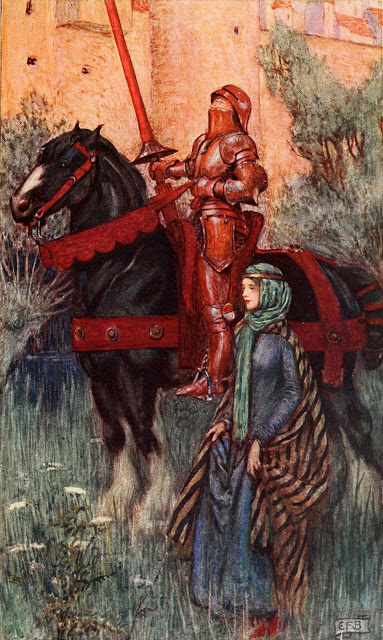
During the first part of the twentieth century Eleanor carried on with her book illustration. In 1909, Ernest Brown, of the Leicester Galleries, commissioned a series of twenty-eight watercolour illustrations to Tennyson’s Idylls of the King, which she painted over two years. They were exhibited in the Dowdeswell Gallery in 1911, and twenty-four of them were published the next year in a deluxe edition of the first four Idylls. The book, Idylls of the King, was a cycle of twelve narrative poems by the English poet Alfred, Lord Tennyson, which retells the legend of King Arthur.
In the painting, above, The Rusty Knight (Yniol’s rusted arms), we see the knight Sir Geraint astride his horse, accompanied by Enid who walks alongside. He has borrowed a suit of armour from her father Yniol to challenge Enid’s other suitor on the tournament ground. Geraint is a flawed character and suffers from jealousy and at times mistrusted Enid. It could be that Eleanor felt for Enid and so mocked Geraint by depicting him, peeking 0ut his ill-fitting suit of armour whilst sat on an over-large horse.

Her 1911 painting, The Passing of Elaine, depicts another female character from Tennyson’s Idylls of the King, which caught the imagination of Eleanor. She was Elaine, a naïve but affectionate young girl who falls in love with Lancelot, but he has no romantic feelings for her. When he tells her that their love can never be, she wishes for death. She orders a chariot bier to take her to the river and place her on a barge, clothed in black upon which she will make her final journey down the river to King Arthur’s Court in the castle at Camelot.
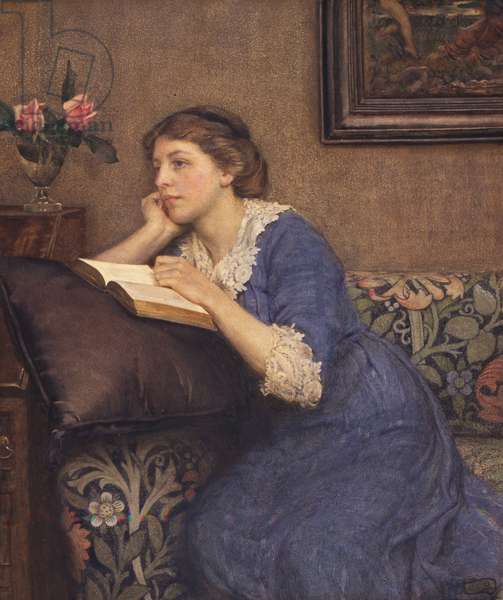
The works of art of Eleanor Fortescue-Brickdale were not all book illustrations, neither were they all Pre-Raphaelite-type paintings. One of my favourite works by Fortescue-Brickdale is a portrait which she completed in 1913. It is a portrait of Winifred Roberts, a student at the Byam Shaw School of Art, where she taught. The portrait was a commission given to Eleanor by Winifred’s grandmother Rosalind Howard. Winifred wears a blue dress with lace trimming. She is sitting on a settee which is covered in a fabric produced by Morris and Company, a furnishings and decorative arts manufacturer and retailer founded by the artist and designer William Morris with friends from the Pre-Raphaelites.
In 1938, Brickdale’s career as an artist and illustrator was cut short when she suffered a stroke and was unable to paint for the last seven years of her life. Eleanor Fortescue-Brickdale died in Surrey on March 10th, 1945 at the age of 73.
Eleanor was acknowledged as having revived the Pre-Raphaelite style of painting at the end of the 19th century and was considered ‘the last survivor of the late Pre-Raphaelite painters’. Her style of painting and her illustrative work had many admirers who baulked at the new modern art which was becoming more popular, what they wanted and what Eleanor gave them was aesthetically pleasing art which told stories.

Beautiful renderings. The details are magnificent. Thank you, once again. Jo
Eleanor Fortescue-Brickdale was my mother`s godmother, I have a number of her works and I am just researching her and her works.
Hi, I have a sketch of Kenmare Bay in the south west of Ireland from 1913 attributed to “Eleanor F Brickdale”…if you come across any letters or information that suggests she stayed here you might be good enough to let me know. I can send on photos if they are of any interest.
Hello David,
If you are researching EFB I expect you have been reading my 2012 exhibition catalogue, A Pre-Raphaelite Journey, from which much of the information given by Jonathan comes. I’d love to hear about your mother’s connection with EFB, as I am still adding to my trove of information about this appealing artist.
A well written and informative description which I enjoyed, thank you. One small point, according to the site freebmd (and many other sites) she died in March 1945 aged 74.